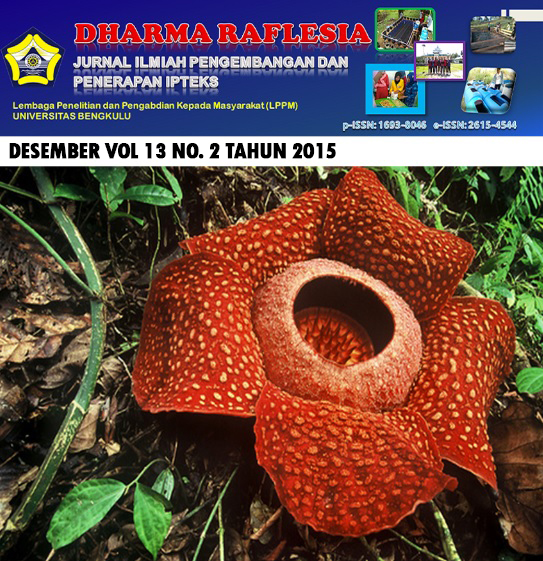Main Article Content
Abstract
The main problem in the people’s rubber in the village of Genting Perangkap and Lubuk Balam, Air Besi, North Bengkulu is a fungal disease that attacks the roots of plants. White root fungus disease (JAP) cause of death in rubber, so that the disease attacks resulted in significant losses. Based on field survey team PPM to land smallholder rubber of Genting Perangkap and Lubuk Balam Village, many found the plants spaces are very close, the stump of a dead rubber tree attacked JAP left alone on the land, and the plants die immediately replaced with new seedlings without eradicate exhausted dead tree stump by JAP. As a result of this new plant will die after the age of 2 years or more, since contracted directly by the fungi Rigidoporus microporus that cause disease JAP from the ground and fungal spores contained in the rubber tree stumps that had not been cleaned. To help the problems of rubber farmers in the village of Genting Perangkap and Lubuk Balam, it is necessary to control training and extension activities of white root fungus disease (JAP) on smallholder rubber plant with a fungicide biological antagonist fungus Trichoderma spp. and the efforts of former rubber plantation land processing stricken JAP. The method used is counseling, training, and applications directly to the field. Having done this activity then: Service target communities have been able to recognize the early symptoms of fungal disease attacks the roots of white, rubber plant spacing was good, as well as the handling of the former rubber plantation land that was attacked by JAP. Target communities have learned how to control the disease by using the JAP antagonist fungus Trichoderma spp. Target communities already have the expertise and is able to reproduce itself Trichoderma spp. and how the application of the newly planted crops, and plants attacked JAP. The outcome of this IbM activity is the product of the fertilizer Trichoderma spp.
Keywords: Farmers, JAP, Rigidoporus microporus, Trichoderma spp.
Article Details
- Authors retain copyright and grant the journal right of first publication with the work simultaneously licensed under a Creative Commons Attribution-ShareAlike 4.0 (CC BY-SA) that allows others to share the work with an acknowledgement of the work's authorship and initial publication in this journal.
- Authors are able to enter into separate, additional contractual arrangements for the non-exclusive distribution of the journal's published version of the work (e.g., post it to an institutional repository or publish it in a book), with an acknowledgement of its initial publication in this journal.
- Authors are permitted and encouraged to post their work online (e.g., in institutional repositories or on their website) prior to and during the submission process, as it can lead to productive exchanges, as well as earlier and greater citation of published work (See The Effect of Open Access).
- This work is licensed under a Creative Commons Attribution-ShareAlike 4.0 International License.
References
- Agustian, A. dan Rachman, B., 2009, Penerapan Teknologi Pengendalian Hama Terpadu Pada Komoditas Perkebunan Rakyat, Perspektif, Vol. 8, No. 1. hal: 30-41. Buku Statistik Perkebunan, 2012.
- Djatmiko, H.A., dan Rohadi, S.S., 1997, Efektivitas Trichoderma harzianum Hasil Perbanyakan dalam Sekam Padi dan Bekatul Terhadap Patogenesitas Plasmodiophora brassicae pada Tanah latosol dan Andosol. Majalah Ilmiah UNSOED, No.2, Vol. 23, hal: 10-22.
- Febbiyanti, T.R., 2012, Penapisan Jamur dan Bakteri Antagonis Terhadap Jamur Akar putih (Rigidoporus Microporus) dari Rizosfer Tanaman Lidah Mertua (Sansevieria Trifasciata Prain), Jurnal Penelitian Karet, No. 1, Vol. 30.
- Gubernur Bengkulu, 2012, Rencana Kerja Pemerintah Daerah, Bengkulu.
- Jayasuriya, K.E. and Thennakoonm, B.I., 2007, Biological Control of Rigidoporus microporus, The Cause of White Root Disease in Rubber, J. Bio. Sci., 36 (1), p: 9-16.
- Muhammad, A., Shadi, A., Harahap, J., Wildan, M., Arini, M.A.D., Gusliana, S., dan Febrina, Y., 2012, Laporan Akhir Kuliah Kerja Nyata Mahasiswa UNIB Periode 67. P3KKN, Lembaga Pengabdian Pada Masyarakat, Universitas Bengkulu.
- Nurhayati, 2011, Penggunaan Jamur dan Bakteri dalam Pengendalian Penyakit Tanaman Secara Hayati yang Ramah Lingkungan, Prosiding Semirata Bidang Ilmu-ilmu Pertanian BKS-PTN Wilaya Barat.
- Rifai, M., Mujim, S., dan Aeny, T.N., 1996, Pengaruh Lama Investasi Trichoderma viride Terhadap Intensitas Serangan Pythium sp. pada Kedelai, Jurnal Penelitian Pertama, No. VII, Vol. 8, hal: 20-25.
- Situmorang, A., 2004, Status dan Manajemen Pengendalian Jamur Akar Putih di Perkebunan Karet, Prosiding Pertemuan Teknis, Pusat Penelitian Karet, Balai Penelitian Sembawa, hal: 66-86.
References
Agustian, A. dan Rachman, B., 2009, Penerapan Teknologi Pengendalian Hama Terpadu Pada Komoditas Perkebunan Rakyat, Perspektif, Vol. 8, No. 1. hal: 30-41. Buku Statistik Perkebunan, 2012.
Djatmiko, H.A., dan Rohadi, S.S., 1997, Efektivitas Trichoderma harzianum Hasil Perbanyakan dalam Sekam Padi dan Bekatul Terhadap Patogenesitas Plasmodiophora brassicae pada Tanah latosol dan Andosol. Majalah Ilmiah UNSOED, No.2, Vol. 23, hal: 10-22.
Febbiyanti, T.R., 2012, Penapisan Jamur dan Bakteri Antagonis Terhadap Jamur Akar putih (Rigidoporus Microporus) dari Rizosfer Tanaman Lidah Mertua (Sansevieria Trifasciata Prain), Jurnal Penelitian Karet, No. 1, Vol. 30.
Gubernur Bengkulu, 2012, Rencana Kerja Pemerintah Daerah, Bengkulu.
Jayasuriya, K.E. and Thennakoonm, B.I., 2007, Biological Control of Rigidoporus microporus, The Cause of White Root Disease in Rubber, J. Bio. Sci., 36 (1), p: 9-16.
Muhammad, A., Shadi, A., Harahap, J., Wildan, M., Arini, M.A.D., Gusliana, S., dan Febrina, Y., 2012, Laporan Akhir Kuliah Kerja Nyata Mahasiswa UNIB Periode 67. P3KKN, Lembaga Pengabdian Pada Masyarakat, Universitas Bengkulu.
Nurhayati, 2011, Penggunaan Jamur dan Bakteri dalam Pengendalian Penyakit Tanaman Secara Hayati yang Ramah Lingkungan, Prosiding Semirata Bidang Ilmu-ilmu Pertanian BKS-PTN Wilaya Barat.
Rifai, M., Mujim, S., dan Aeny, T.N., 1996, Pengaruh Lama Investasi Trichoderma viride Terhadap Intensitas Serangan Pythium sp. pada Kedelai, Jurnal Penelitian Pertama, No. VII, Vol. 8, hal: 20-25.
Situmorang, A., 2004, Status dan Manajemen Pengendalian Jamur Akar Putih di Perkebunan Karet, Prosiding Pertemuan Teknis, Pusat Penelitian Karet, Balai Penelitian Sembawa, hal: 66-86.
